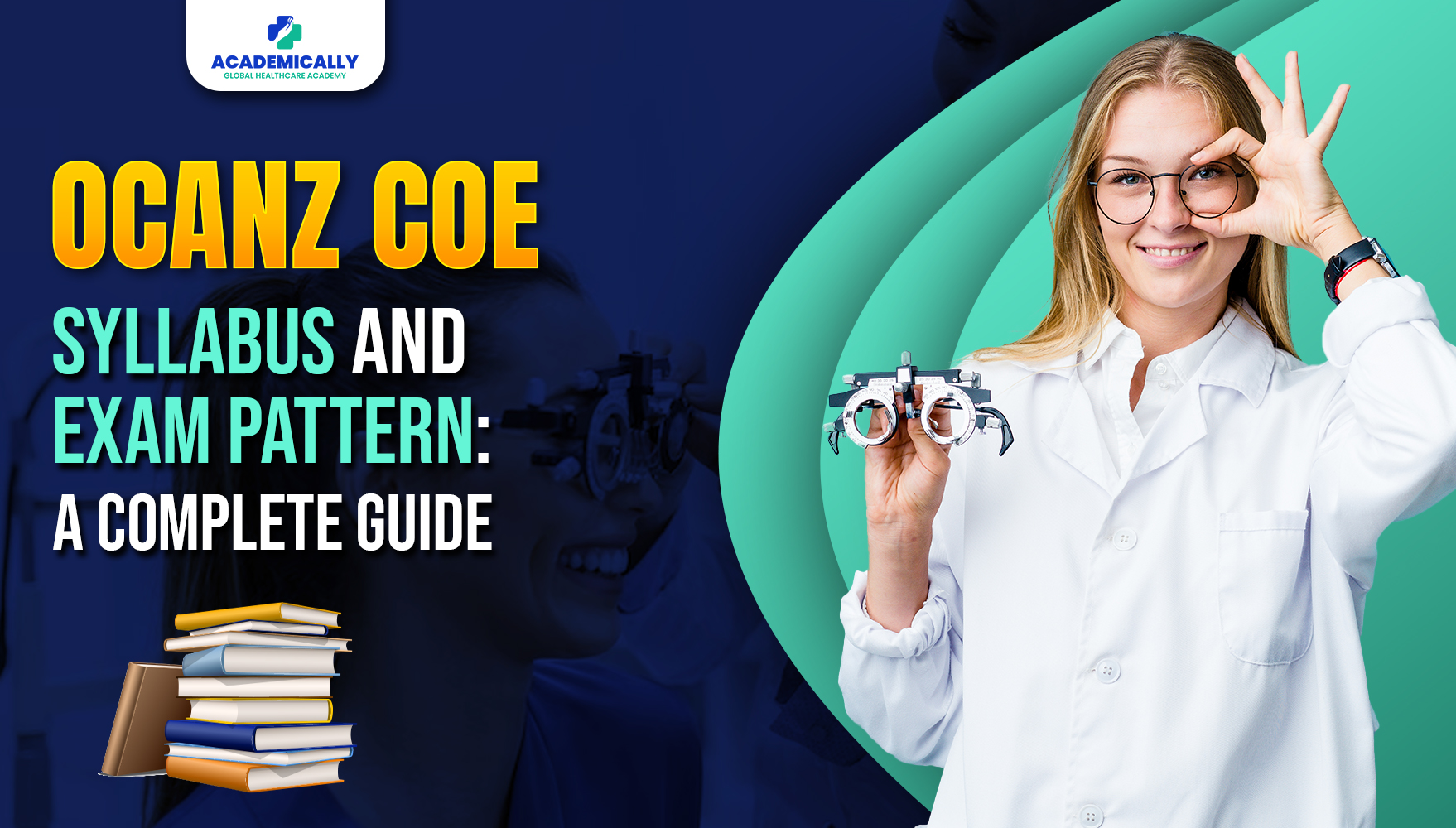About the Examination
- Written Examination
- Cultural Safety Training
- Clinical Examination
Written Exam
The written examination consists of two parts:
- Clinical Science Examination
- Diagnosis and Management Examination
Clinical Science Examination (Part 1)
Let's see the exam pattern and syllabus through which candidates are assessed for part 1.
Exam Pattern
The Clinical Science Examination is a 3-hour paper with 144 multiple-choice questions (MCQs) assessing the candidate's knowledge in biomedical, vision, optical, and clinical science. The exam evaluates the candidate's ability to apply this knowledge in clinical situations.
Of the 144 MCQs, 120 are scored to determine the overall result. The remaining 24 questions are non-scored and used to calibrate new questions for future exams. However, these non-scored questions do not contribute to the candidate's final score. Candidates won't be informed which questions are non-scored.
Each MCQ presents four options (a, b, c, and d), and the candidate must choose the BEST correct answer. Marks are awarded only for correct answers, with no deductions for incorrect responses.
Syllabus
The candidates are assessed based on the following factors:
Professional Responsibilities
- Maintains knowledge, expertise and skills
- Integration of clinical expertise.
- Provides advice and information to patients and others
- Legal obligations involved in optometric practice
- Factors that affect the community's need for optometric services
Communication and Patient History
- Interpretation of patient information, for example, from other professionals and previous histories.
Patient Examination
- Formulates and Implements examination plan
- Assessment of the ocular adnexa and the eye muscles
- Assessment of visual processing
- Assessment of significance of signs and symptoms found during ocular examination: ocular, visual and non-ocular signs and symptoms: social, emotional, neurological factors, etc.
Diagnosis and Management
- Prognosis
- Spectacles
- Dispensing of optical prescriptions
- Contact lenses
- Low vision devices
- Visual therapy program
- Referral and receipt of referrals
- Provision of pre-and post-operative co-management with Ophthalmologists
- Advice on vision in the workplace
Health Information Management
- Storage and security of patient records
- Legislative requirement regarding record retention/destruction
Diagnosis and Management Examination (Part 2)
Let's see the exam pattern and syllabus through which candidates are assessed for part 2.
Exam Pattern
The Diagnosis and Management paper is a 3-hour examination. It consists of 18 short answer questions (SAQs), with many questions having multiple components related to case histories.
These questions often involve the analysis of clinical scenarios accompanied by photographs depicting various conditions. This format challenges candidates to apply their knowledge to practical situations, making diagnoses and suggesting appropriate management strategies based on the information presented in the cases.
Syllabus
- Formulation of examination plan, assessment of the ocular adnexa and the eye, diagnosis
- Assessment of pupil function, establishment of diagnoses, interpretation and analysis of findings to establish a diagnosis, including formulation and implementation of examination plan
- Treatment/management program:
- Prescription of contact lenses, including formulation and implementation of an examination plan
- Assessment of visual fields and colour vision, including examination plan and interpretation and analysis of findings to establish a diagnosis
- Assessment of oculomotor and binocular function, including examination plan, including interpretation and analysis of findings to establish a diagnosis
- Significance of incidental findings/investigation of ocular signs and symptoms
- Contact lens aftercare, including examination plan
- Referral of the patient/choice of practitioner for referral
- Treatment of adnexal and anterior eye disorders
- Provision of pre-and postoperative management
- Advice on vision in the workplace
- Emergency care and eye health promotion
Cultural Safety Training
OCANZ is committed to promoting equitable access and outcomes in eye care services for Aboriginal, Torres Strait Islander, and MÄori communities, free from stigma, racism, or fear.
As part of the Competency in Optometry Examination process, OCANZ mandates the Cultural Safety Training for Optometrists online program for all internationally qualified optometrists.
The curriculum is delivered through six tutorials comprising 28 short lessons, with an approximate time commitment of 5 hours excluding assessment tasks. The program, designed for self-pacing, accommodates candidates' schedules, allowing them to log in at their convenience.
The assessment process includes interactive quizzes, short answer questions based on clinical scenarios, and a final multiple-choice exam. Achieving a minimum score of 80% on the six post-tutorial assessments and the exam is required for successful completion.
Completion of the Cultural Safety Training for Optometrists online program is a prerequisite for candidates proceeding to the clinical component of the COE (Competency in Optometry Examination).
Clinical Examination
The Clinical Examination consists of two parts:
- Skills Station Examination (Part 1)
- Patient Examination (Part 2)
Skills Station Examination (Part 1)
In the Skills Station examination, candidates are required to showcase proficiency in 12 optometric skills across six stations. Successful completion of all 12 skills is necessary to pass the examination.
The examination involves six stations, with candidates rotating between them. Each station requires the demonstration of two different skills. The candidate has 30 minutes at each station, and the allocation of time between the two skills is at the candidate's discretion.
Failing any essential criterion leads to the failure of the entire skill. Failing three or more desirable criteria results in the failure of that specific skill.
Candidates falling short in up to three of the 12 skills may have the opportunity to re-sit the failed skills the next day as part of a supplementary examination. However, failing four or more skills on the initial attempt or any skill/s during the second attempt constitutes an overall failure of the Skills Station examination.
In the event of a supplementary examination, each skill being re-examined must be completed within 20 minutes.
Patient Examination (Part 2)
In this, the candidate is assessed on
- his/her ability to communicate clearly to the patient, including the ability to explain the purpose of each test and what is expected of the patient in the course of each test
- the ability to perform each test
- the coordination of the examination
- the ability to make an accurate diagnosis and to determine appropriate management or treatment.
To pass the examination, the candidate must complete a minimum of three out of four patient exams within 70 minutes. Each patient exam requires the candidate to achieve an average mark of 1 in each of the six sections of the marking rubric.
Failure in any one section results in an overall failure for that patient. Following the examination, additional time is allocated for discussing the case with the assessor, whose comments and overall marks contribute to the final result determination.
Candidates receive only the patient's name, gender, and date of birth without access to prior clinical records. The examination should be approached as the patient's initial visit.
Conclusion
In the journey towards passing the OCANZ COE, the syllabus and exam pattern serve as the roadmap and compass, guiding candidates to demonstrate not just knowledge but the practical skills and cultural competence required for success.
As Benjamin Franklin said, 'By failing to prepare, you are preparing to fail.' Understanding and mastering the prescribed syllabus and exam structure is an essential component of the COE exam preparation to pass the exam with flying colours.
The journey towards excellence requires preparation, preparation with the best. Academically has designed a course specifically for the COE Exam, where you will get all the guidance to clear the exam on the first attempt.
For more information about this course, please contact us.




